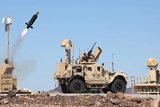Details revealed on new UAS munition destined for Ukraine
The twin x-wing platform has a length of 1.12m. (Photo: Helsing)
German artificial intelligence (AI) and drone company Helsing has released details on its HX-2 attack uncrewed aerial system (UAS) which is set to be deployed in Ukraine where underlying technology of the system is already in use.
The platform is described by the company as “software-based, mass-producible and swarm-capable, electrically-propelled, twin x-wing-precision munition with up to 100 km range”.
The platform has weight of 12kg with a warhead payload of 4.5kg and a maximum speed of 250kmh. Propellers are mounted on the rear x-wings and the UAS has a length of 1.12m.
Related Articles
Defence AI company Helsing envisions benefits for ASW, amplifying sensor capabilities
Germany adds AI backbone to FCAS next-generation fighter jet
Saab partners with Helsing to get AI on Gripen E aircraft
A key feature of the system is an on-board computer which runs the AI component. Combined with stored map data, it allows for operation in satellite- or GPS-denied environments. Navigation is provided by the platform identifying landmarks.
When operating as part of Helsing’s Altra recce/strike software, multiple HX-2s can assemble into swarms controlled by one operator.
It is designed to be mass-producible and at unit cost less than conventional systems. Helsing is ramping up production in Europe with first deliveries to Ukraine expected in early 2025.
In announcing the UAS the company repeatedly highlighted the platforms use in Ukraine and with one operational scenario “being deployed along borders at scale, HX-2 can serve as a powerful counter invasion shield against enemy land forces”.
Additionally, “NATO urgently requires technology to protect the integrity of the Eastern Flank [and] we’ve invested to develop this capability and give NATO an edge through precision mass”.
In February last year the company announced it was opening a headquarters in the UK. The UK Ministry of Defence noted this was part of a plan to mass-produce thousands of a new AI-enabled UAS over the next five years within a £350 million (US$442 million) investment.
Related Programmes in Defence Insight
Related Equipment in Defence Insight
More from Air Warfare
-
![India readies private sector push as AMCA moves towards 2028 prototype]()
India readies private sector push as AMCA moves towards 2028 prototype
India’s stealth fighter ambitions gain fresh momentum as HAL opens the door to private sector involvement in AMCA Mk1A structural assembly, with strategic support growing for next-gen propulsion and sensor technologies.
-
![BAE Systems reveals new GCAP demonstrator design with plans to fly by 2027]()
BAE Systems reveals new GCAP demonstrator design with plans to fly by 2027
A key part in the trinational Global Combat Air Programme (GCAP), this is the first crewed supersonic aircraft demonstrator to be built and developed in the UK in more than 40 years.
-
![Anduril’s Barracuda-100M completes latest successful test flights]()
Anduril’s Barracuda-100M completes latest successful test flights
The munitions variant of the Barrauda-100 autonomous air vehicle is being tested for the US Army’s High-Speed Manoeuvrable Missile (HSMM) testbed programme, with further flight tests expected in 2026.





















